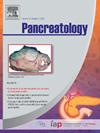可解释人工智能在指导胰腺囊肿患者治疗中的表现
IF 2.8
2区 医学
Q2 GASTROENTEROLOGY & HEPATOLOGY
引用次数: 0
摘要
根据恶性转化的风险,胰腺囊肿的治疗可分为三种不同的途径--出院、监测或手术。本研究比较了人工智能(AI)模型和临床护理在这项任务中的表现。研究使用一个公开可用的数据集,开发了两种可解释助推机(EBM)模型,并仅使用临床特征或临床特征和囊液分子标记物(CFMM)对其进行了评估,该数据集由 850 个病例(中位年龄 64 岁;65% 为女性)组成,其中有独立的训练群组(429 个病例)和保持测试群组(421 个病例)。其中有 137 个无恶性可能的囊肿、114 个恶性囊肿以及 599 个 IPMN 和 MCN。与目前的临床治疗(0.62 和 0.58)相比,EBM 和 EBM with CFMM 模型在识别需要监测(0.88 和 0.82)和手术(0.66 和 0.82)的患者方面分别具有更高的准确性。在出院方面,EBM 和 CFMM 模型的准确度(0.91)高于 EBM 模型(0.84)或当前临床护理(0.86)。在接受手术切除的患者队列中,与临床治疗相比,使用EBM-CFMM模型可减少59%的不必要手术(92人),增加7.5%的正确手术(11人),识别出122%需要监测的患者(76人),增加138%正确分类出院的患者(18人)。与临床治疗或之前的人工智能模型相比,EBM 模型在确定正确治疗方面具有更高的灵敏度和特异性。该模型的预测结果可由临床医生进行解释。本文章由计算机程序翻译,如有差异,请以英文原文为准。
Performance of explainable artificial intelligence in guiding the management of patients with a pancreatic cyst
Background/objectives
Pancreatic cyst management can be distilled into three separate pathways – discharge, monitoring or surgery– based on the risk of malignant transformation. This study compares the performance of artificial intelligence (AI) models to clinical care for this task.
Methods
Two explainable boosting machine (EBM) models were developed and evaluated using clinical features only, or clinical features and cyst fluid molecular markers (CFMM) using a publicly available dataset, consisting of 850 cases (median age 64; 65 % female) with independent training (429 cases) and holdout test cohorts (421 cases). There were 137 cysts with no malignant potential, 114 malignant cysts, and 599 IPMNs and MCNs.
Results
The EBM and EBM with CFMM models had higher accuracy for identifying patients requiring monitoring (0.88 and 0.82) and surgery (0.66 and 0.82) respectively compared with current clinical care (0.62 and 0.58). For discharge, the EBM with CFMM model had a higher accuracy (0.91) than either the EBM model (0.84) or current clinical care (0.86). In the cohort of patients who underwent surgical resection, use of the EBM-CFMM model would have decreased the number of unnecessary surgeries by 59 % (n = 92), increased correct surgeries by 7.5 % (n = 11), identified patients who require monitoring by 122 % (n = 76), and increased the number of patients correctly classified for discharge by 138 % (n = 18) compared to clinical care.
Conclusions
EBM models had greater sensitivity and specificity for identifying the correct management compared with either clinical management or previous AI models. The model predictions are demonstrated to be interpretable by clinicians.
求助全文
通过发布文献求助,成功后即可免费获取论文全文。
去求助
来源期刊

Pancreatology
医学-胃肠肝病学
CiteScore
7.20
自引率
5.60%
发文量
194
审稿时长
44 days
期刊介绍:
Pancreatology is the official journal of the International Association of Pancreatology (IAP), the European Pancreatic Club (EPC) and several national societies and study groups around the world. Dedicated to the understanding and treatment of exocrine as well as endocrine pancreatic disease, this multidisciplinary periodical publishes original basic, translational and clinical pancreatic research from a range of fields including gastroenterology, oncology, surgery, pharmacology, cellular and molecular biology as well as endocrinology, immunology and epidemiology. Readers can expect to gain new insights into pancreatic physiology and into the pathogenesis, diagnosis, therapeutic approaches and prognosis of pancreatic diseases. The journal features original articles, case reports, consensus guidelines and topical, cutting edge reviews, thus representing a source of valuable, novel information for clinical and basic researchers alike.
 求助内容:
求助内容: 应助结果提醒方式:
应助结果提醒方式:


